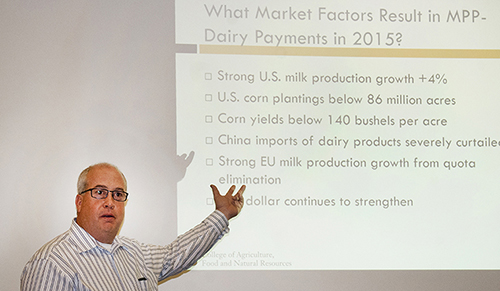
Instead, it's a highly unlikely, but still reality-based, look at what it might take for every dairy that signs up for MPP to collect maximum payments during 2015 – payments that, frankly, would mean the dairy industry was in dire trouble if they occurred.
The short version: imagine 2009 all over again.
The long version is serious food for thought from dairy economist Scott Brown (pictured above) at the University of Missouri, who helped USDA design the program.
Speaking at a series of four producer MPP meetings across Idaho this week, Brown pointed out that all of the elements that might trigger a 2009-scale meltdown in 2015 are familiar and/or at least partly in sight today:
- Huge growth in U.S. milk production. Brown's example of 4 percent is actually less than September's 4.1 percent gain reported by USDA, due to less culling, rising cow numbers, cheaper feed prices, and very strong production per cow.
- Significantly fewer planted corn acres in response to sharply lower prices. Brown's example was 86 million acres, versus 91.8 million planted in 2014. Much lower corn prices, of course, have already happened.
- A terrible drought that cripples crop yields and sends feed prices skyrocketing. Brown's example was 140 bushel per acre corn, which is 30 percent less than USDA's 2014 forecast two weeks ago. Droughts are more or less impossible to predict, but they do happen don't they?
- A big slowdown in China's economy that causes huge cutbacks in its dairy imports. While its yearly gross domestic product growth is still the envy of virtually every country in the world, 2014 has seen China's smallest gain in five years (7.3 percent), and 2014 dairy imports have already declined significantly from recent stratospheric levels.
- A global surplus of dairy products that crushes U.S. farm milk prices. Brown didn't have a target; he simply pointed out that 2015 Class III futures are already one-third less than their highs of 2014.
- Higher global milk production that increases the product glut. Decades-old quotas in the European Union will end on April 1, 2015, and three of its biggest producers (Germany, Holland and Ireland) have been ramping up output by 4 to 6 percent in 2014. "We are going to get more global milk supplies in 2015," Brown warned.
- The value of the Dollar continues to strengthen, making our products more expensive for international buyers. This has been happening for much of 2014, particularly against the euro, pound and yen. Despite its warts, the U.S. economy still looks healthier than everyone else's.
"Another 2009 is a worst-case scenario," he admitted. "But is it repeatable? Yes. Is it likely? No. My point is that we're not done seeing milk prices of $12 to $13 in the U.S. I don't know when they'll happen, but I don't think we're done, especially with the way feed costs are coming down."
That's the outline for a worst-case MPP scenario – an explosion in feed costs and a collapse in milk prices that slash income over feed costs (IOFC) to zero. At that point, every dairy that signed up for even the "free" minimum coverage of $4 per hundredweight would collect full payments.
But seriously, how much good would they do? Because if the U.S. dairy industry ever sees an IOFC situation again that approaches $0, MPP checks won't come close to helping many farms survive.

The author has served large Western dairy readers for the past 37 years and manages Hoard's WEST, a publication written specifically for Western herds. He is a graduate of Cal Poly-San Luis Obispo, majored in journalism and is known as a Western dairying specialist.







